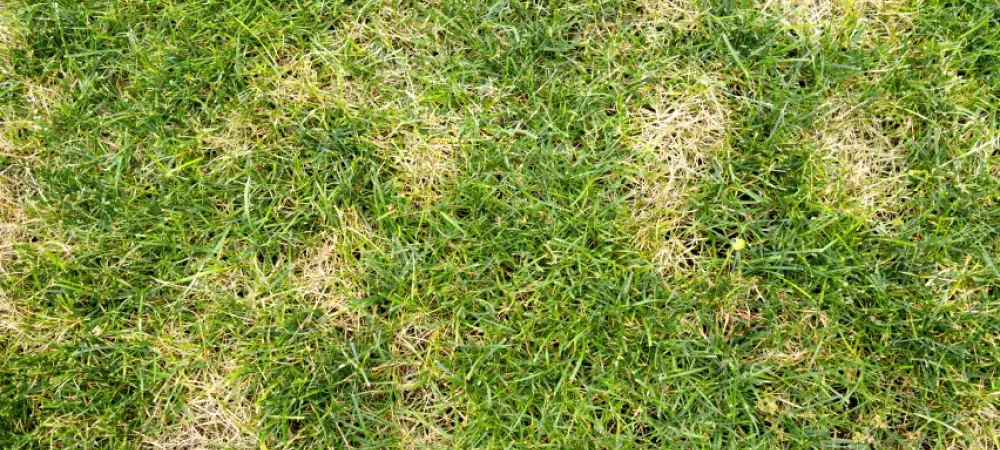Common Lawn Diseases

Summer is the time when growing cool-season turf in this region can be challenging. Grasses such as fescue, bluegrass, and perennial ryegrass are all considered cool-season turfgrasses and struggle from disease and summer stress. Summer stress is based on heat and drought conditions. As we go through the summer, it is important to keep up with proper watering and be on the brown patch lookout for disease and turfgrass under summer stress. The challenge with summer lawn stress is that it may appear to be a turf disease. Some of the most common lawn stresses that appear in the summer are Heat Stress and Drought Stress, both of which can turn your lawn brown, making them easily confused with turf disease.
Identifying Heat and Drought Stress This Summer:
Water is critical to the growth of all plants, not just turfgrass. Water is a key part of photosynthesis and respiration reactions, as well as many other plant metabolic activities. Turfgrass leaves and shoots are comprised of approximately 80% water. A lack of water (rainfall or irrigation) leads to a decrease in growth due to a decrease in photosynthesis and plant respiration and an increase in plant temperature (lack of transpirational cooling; analogous to humans not being able to sweat).
Each turf species responds to drought differently. Some grasses such as Kentucky bluegrass enter a summer dormancy when soils begin to dry. Summer dormancy is a process where the brown patches of grass plant stop growing and turns brown (dormant), but the turf is not dead. When rainfall returns following drought, Kentucky bluegrass will emerge from summer dormancy and resume normal growth. Other turfgrasses such as tall fescue and perennial ryegrass maintain more of their color, but top growth slows reduce mowing frequency. Some of the most obvious signs of dry conditions are when the grass blades wilt and the turfgrass shows signs of purple coloring prior to browning. Another sign of dry conditions is when footprints or tire tracks from the mower do not bounce back and are visible for a prolonged period of time.
Turf Diseases You Might See
Distinguishing the different turfgrass diseases can be a great challenge due to the similarities in their appearance. Turfgrass diseases when inspected closely, typically have small brown lesions and irregular pattern formations. More detailed information about these diseases is available on our website. Lawns that are dry and/or under heat stress show signs on a bigger scale. Also, summer stress patterns may occur under certain conditions including but not limited to full sun exposure, lawn slope, compact soils, and poor soil conditions.
Brown Patch
Brown patch appears in circles of brown or tan ranging from just a few inches to several feet in width. Brown patch can grow when hot, humid conditions persist overnight. Other contributing factors include soil compaction, poor drainage, watering too much, and watering too in the late afternoon. Brown patch will weaken and eventually kill your grass, making it easy for weeds and pests to take over. The damage left behind can take weeks or months to repair. Preventing brown patch is as easy as overseeding with different varieties of grass and ensuring your grass dries out before the sunsets.
Dollar Spot
Dollar spot is another lawn disease caused by overwatering or poor soil drainage. Dollar spot appears as bleached areas of grass that grow in size and merge with other spots. Grass affected with dollar spot looks wet with yellow spots ringed in reddish-brown. Symptoms might not appear until the early summer so it’s best to establish a good watering habit or get an automatic sprinkler system with a timer. Dollar spot affects perennial ryegrass, fine fescue, centipede grass, tall fescue, Kentucky bluegrass, Zoysia grass, and Bermudagrass.
Red Thread
Red thread attacks grass from early to late spring and again from late summer into fall. Perennial ryegrass and fine fescue are the prime targets for red thread, but it can affect bluegrasses and bentgrasses as well. The disease is characterized by reddish-pink threads that form on the blades of your grass. This can stick to your mower, shows, and tools and can be used to spread to other parts of your lawn. Red thread is prevalent in wet spring temperatures, shady areas, and areas with poor air circulation. To control red thread, remove infected lawn clippings and lawn damage, fertilize with products high in nitrogen. Aerate compacted soil to remove thatch and improve air circulation.
Necrotic Ring Spot
Also called fusarium blight, necrotic ring spot is an aggressive disease that attacks the roots and crowns of cool-season grasses such as ryegrass, Kentucky bluegrass, and the fescues. It appears as light green spots on the grass that range from several inches to several feet in width. Affected grass on the outer edge of the patch begins to die while the grass in the center remains green, giving it a frog eye or donut appearance. A pink layer of fungus can be seen near the soil line. Fusarium blight is common in areas that have been stressed from drought and in areas in full sun. Follow proper irrigation and fertilization practices and get your lawn aerated regularly.
Choose Us! The Professionals At Nuleaf Have You Covered
With everything that has been going on the past year and a half, it is likely that you will want to be out and about… Not at home worrying about turf diseases and how you can make your lawn the best it can be. With Nuleaf, you can leave the work up to us. We are trained and armed with years of experience to take care of any lawn issue you might have.
When you are ready to take the next step with your lawn, check out our lawn care program and turf disease control program. If you are looking to go a step further, we also offer our clients a plant healthcare program.
Don’t forget to:
Visit our website for more information on both programs.
Call us today at 703-989-9405.
Check out our blog for more helpful tips on lawn care.
Contact us on our site.

